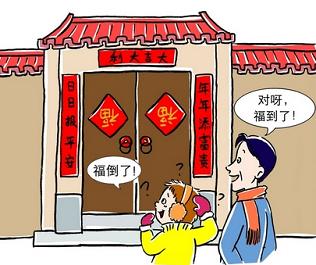
Pasting Paper-cuts
贴窗花
Paper-cuts, usually with auspicious patterns, give a happy and prosperous atmosphere of the Festival and express the good wishes of Chinese people looking forward to a good life. In addition to pasting paper-cuts on windows, it is common for Chinese to paste the character "fu(福)", big and small, on walls, doors and doorposts around the houses. "Fu(福)" shows people's yearning toward a good life. Some people even invert the character "fu(福)" to signify that blessing has arrived because "inverted" is a homonym for "arrive" in Chinese. Now many kinds of paper-cuts and "fu(福)" can be seen in the market before the Festival.
通常带有吉祥图案的窗花传递节日喜庆和热闹的气氛和表达中国人期待幸福生活的美好愿望。除了贴窗花,在墙上,门上和房子周围的门框上贴大小福字是中国人表达对美好生活渴望的普遍习俗。一些人甚至倒贴福字来表示福到了,因为在汉语中“倒”是“到”的谐音。现在在春节前的市场上随处可见各种各样的窗花和福字。
Giving Hongbao
给红包
Giving Hongbao (red packets or red envelopes) during the Chinese New Year is another tradition. A red packet is simply a red envelope with gift money in it, which symbolizes luck and wealth.
过春节的另一个传统就是要给红包,就是在一个红色的小红包里装上钱,寓意为幸运和财富。
Red is the lucky color and will bring good luck to the person receiving the present. Red packets are symbolically handed out to younger generations by their parents, grandparents, relatives, close neighbors and friends, and usually the lineal family gives Hongbao to the children on New Year's Eve. Money given in this way may not be refused and the pretty envelopes make the present seem more amiability and sincere.
红色是幸运色,能给收到红包的人带来好运。红包一般是父母给儿女,爷爷奶奶给孙儿孙女,或者亲戚朋友给小孩子的,一般来说,都是除夕夜给的。
The money is also called ya sui qian, meaning "money for suppressing age", which is supposed to stop children from getting older. This comes from the belief that everyone becomes one year older on New Year's Day.
这笔钱也称作是压岁钱,希望孩子们永远不要长大,因为大家都觉得一年一岁催人老。
Starting from the second day, people begin going out to visit friends and relatives, taking with them gifts and Hongbao for the children.
大年初一串亲戚朋友,也要给孩子送礼物和红包。












